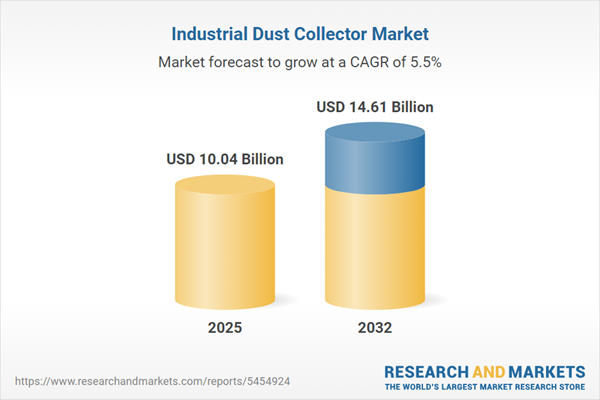Speak directly to the analyst to clarify any post sales queries you may have.
Industrial dust control has become central to risk mitigation and operational excellence as organizations address increasingly complex compliance and workplace safety standards across global markets.
Market Snapshot: Industrial Dust Collector Market
The industrial dust collector market is advancing on the back of evolving environmental requirements, rising workplace safety expectations, and increased capital investment. Industry research indicates that the sector is set to expand from USD 9.51 billion in 2024 to USD 10.04 billion in 2025, representing a compound annual growth rate of 5.51 percent. Growth is being fueled by the adoption of digital dust collector systems, new compliance benchmarks, and a pronounced shift toward operational efficiency. Decision-makers are directing resources into technologies that not only optimize workforce safety and productivity but also ensure adaptability to diverse and changing regulatory environments. These investments are crucial for organizations managing operations across multiple regions and industry verticals.
Scope & Segmentation: Industrial Dust Collector Market
Senior executives are leveraging this market analysis for planning and prioritizing targeted investments that align with evolving regulations and strategic goals. The market is being transformed by rapid innovation, scalable offerings, and global expansion.
- Product Types: Bag filter systems, cartridge filters, cyclone collectors, electrostatic precipitators, and wet scrubbers address distinct dust capture needs and operational requirements.
- End-User Industries: Cement, mining, chemical processing, pharmaceuticals, food and beverage, metallurgy, and power generation sectors each face specialized dust management challenges and regulatory considerations.
- Airflow Capacity: Compact dust collectors serve confined spaces, while full-scale solutions manage high-volume processes in complex industrial operations.
- Filter Materials: Options like glass fiber, engineered polyester, and synthetic fibers ensure reliable filtration under demanding conditions.
- Mobility: Stationary installations suit fixed operations, with mobile units providing agility for flexible or phased facility layouts.
- Operation Modes: Batch and continuous processing models support different automation and maintenance strategies based on facility needs.
- Regional Segmentation: The Americas, Europe, Middle East and Africa, and Asia-Pacific each feature unique regulatory, economic, and adoption patterns influencing investment.
- Manufacturer Coverage: Leading firms such as Donaldson Company, Inc., Parker-Hannifin Corporation, and Nederman Holding AB, alongside new entrants, are innovating dust collection technologies for global clients.
Key Takeaways for Executives
- Deployment of digital monitoring platforms supports real-time oversight of dust collection processes, improving responsiveness to changing compliance requirements and operational issues.
- Sector-specific solutions enable organizations to address unique exposure risks, enhance compliance, and support robust health and safety strategies for their workforce.
- Collaboration across manufacturing, integration, and supply networks increases the adaptability and lifecycle upgradability of dust control infrastructure.
- Regional priorities shape technology adoption, with some markets driving modernization, others focusing on modular compliance, and regions like Asia-Pacific emphasizing rapid facility development.
- Supply chain adjustments, such as sourcing diversification and localizing suppliers, play a key role in steadying operations amid fluctuating regulatory and trade landscapes.
Tariff Impact and Supply Chain Adjustments
In response to recent tariff increases on critical dust collector components, companies are adapting by optimizing sourcing models, consolidating operations near production hubs, and streamlining logistics. These measures reinforce reliability and continuity, helping organizations manage risk as global trade conditions remain dynamic.
Methodology & Data Sources
This research reflects insights gained through direct interviews with industry leaders, analysis of leading publications, patent literature, and peer-reviewed studies. All findings have been validated by experts to align with executive decision-making needs in dust control strategy.
Why This Report Matters
- Offers practical frameworks supporting the adoption of digital and modular dust control solutions, providing a basis for regulatory planning and operational initiatives.
- Facilitates capital planning, strengthening compliance management and resilience during shifts in standards and risk exposure.
- Guides sourcing and maintenance optimization to help reduce operational uncertainty and sustain high system performance over time.
Conclusion
Executives can use this analysis to inform risk management decisions, advance compliance, and ensure resilient industrial dust control infrastructure in evolving global markets.
Additional Product Information:
- Purchase of this report includes 1 year online access with quarterly updates.
- This report can be updated on request. Please contact our Customer Experience team using the Ask a Question widget on our website.
Table of Contents
3. Executive Summary
4. Market Overview
7. Cumulative Impact of Artificial Intelligence 2025
Companies Mentioned
The companies profiled in this Industrial Dust Collector market report include:- Donaldson Company, Inc.
- Parker-Hannifin Corporation
- Nederman Holding AB
- Camfil AB
- FLSmidth & Co. A/S
- 3M Company
- Eaton Corporation PLC
- Mitsubishi Heavy Industries, Ltd.
- Filtration Group Corporation
- MANN+HUMMEL GmbH
Table Information
| Report Attribute | Details |
|---|---|
| No. of Pages | 184 |
| Published | November 2025 |
| Forecast Period | 2025 - 2032 |
| Estimated Market Value ( USD | $ 10.04 Billion |
| Forecasted Market Value ( USD | $ 14.61 Billion |
| Compound Annual Growth Rate | 5.5% |
| Regions Covered | Global |
| No. of Companies Mentioned | 11 |









